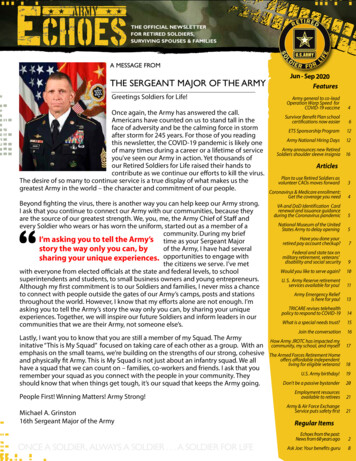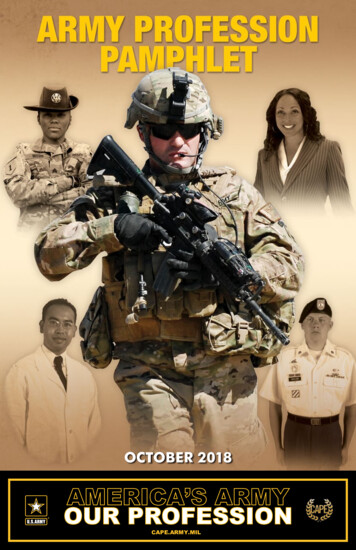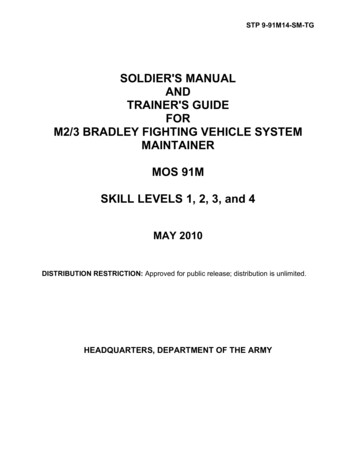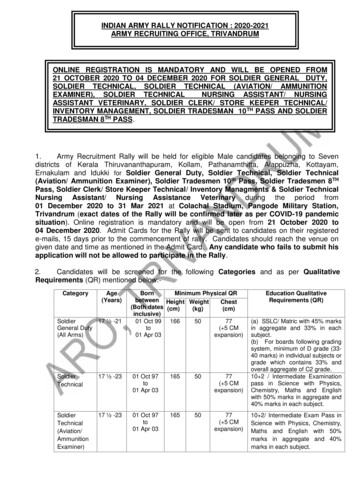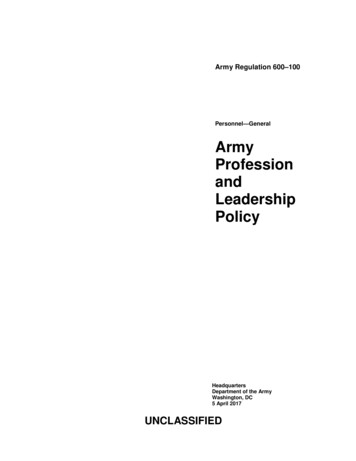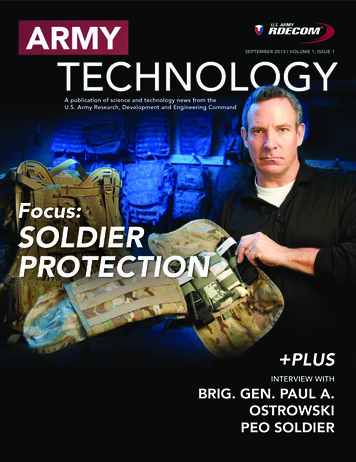
Transcription
September 2013 Volume 1, ISSUE 1A publication of science and technology news from theU.S. Army Research, Development and Engineering CommandFocus:SOLDIERPROTECTION PLUSINTERVIEW WITHBRIG. GEN. PAUL A.OSTROWSKIPEO SOLDIER
IEM Salutes RDECOMCongratulations on Army Technology Magazine’s Inaugural IssueIEM is proud to continue 16 years of science and technology support to: U.S. Army Research, Development and Engineering Command Headquarters Army Research Laboratory Edgewood Chemical Biological CenterIEM solutions are used in the field, not placed on a shelf. Science-Based CBRNE Protection Strategies Requirements Analysis and Development Research, Technical and Analytical Reviews 3-D Virtual and Interactive Training Systems Modeling, Simulation, and Analysis Systems Integration Testing and Evaluation Product Development and Lifecycle Support2400 Ellis Road, Suite 200 Research Triangle Park, NC 27703 800.977.8191 www.iem.comWashington, D.C. Bel Air, Maryland Salt Lake City, Utah Baton Rouge, Louisiana Anniston, AlabamaFort Leonard Wood, Missouri Pueblo, Colorado Richmond, Kentucky Delhi, IndiaIEMwww.iem.com
In this IssueSeptember 2013 Volume 1, ISSUE 1features3Protecting the SoldierBrig. Gen. Paul A. Ostrowski, PEO Soldier, answers questionsabout a wide range of projects that will further increaseSoldier protection.5Piece of MindArmy, university researchers partner to study mild traumaticbrain injuries. By T’Jae Gibson, ARL Public Affairs7The Virtual DimensionTo simulate blast effects on Soldiers, engineers redesignvirtual models and manikins to more closely reflectoperational realities. By Dan Desmond, TARDEC Public Affairs9Technological OvermatchAt AMRDEC, about 10,000 people deliver collaborativeand innovative technical capabilities for responsive andcost-effective research, product development and life-cyclesystems engineering solutions to protect Soldiers.The work provides Soldiers with capabilities designed toexceed those of America’s enemies and enhance survival.By AMRDEC Public Affairs11Tested Tactical Protection for SoldiersArmy lab is laser focused on testing and ultimately fieldingindividual Soldier protection equipment.By Alexandra Foran, NSRDEC?The flame-resistant Army Combat Shirt is wornunder the Interceptor Body Armor insteadof the Army Combat Uniform or the ArmyAircrew Combat Uniform jacket and standardissue T-shirt, reducing bulk for Soldiers operating in extreme climates. Read more abouthow PEO Soldier seeks the next generation ofSoldier protection gear on Page 21.15Protecting the Soldier, Preserving the NationFor 96 years ECBC has advanced the development ofindividual and collective protection equipment. By ECBCCommunications18New BootsWhen talking tactics, the talk always centers around boots onthe ground. Here is the art and science of new footwear. ByBob Reinhart, USAG-Natick Public Affairs19Conformal BatteryLess weight and more power is what every Soldier dreams of.By Dan Lafontaine, RDECOM Public Affairs21Army Seeks Next Generation of ProtectionNever satisfied with past successes, SPIE works to keep theAmerican Soldier the best equipped in the world.By Doug Graham, Public Affairs, Project Manager SoldierProtection & Individual Equipment. By Debra Dawson, PEOSoldier Public AffairsRDECOMResearch, Development and Engineering CommandAMCU.S. Army Materiel CommandAMCOM-LCMCLife Cycle Management CommandAMRDECAviation and Missile Research, Development andEngineering CenterARLArmy Research LaboratorySoftware Model Tests LethalitySoftware model tests lethality and maximizes smart weaponperformance model. By T’Jae Gibson, ARLARDECU.S. Armament Research, Development and EngineeringCenterASA(ALT)Assistant Secretary of the Army for Acquisition, Logistics andTechnologyCERDECCommunications-Electronics Research, Development andEngineering CenterECBCEdgewood Chemical Biological CenterNSRDECNatick Soldier Research, Development and EngineeringCenterPEO SoldierProgram Executive Office SoldierProject Manager Soldier Protection and IndividualEquipment23DepartmentsOn the cover: NSRDEC equipment designerRich Landry displays the new individual firstaid kit. Read more on Page 11 (U.S. Armyphoto by David Kamm)Acronym Guide1Acronym GuidePM SPIE2Director’s CornerTARDEC25Tank Automotive Research, Development and EngineeringCenterNewsBriefsUSAG NatickU.S. Army Garrison Natick
Director’s CornerWelcome to the premier issueof Army Technology Magazine. Inthis edition, we focus on Soldierprotection. Our Soldiers are ourmost valuable asset. The articlesin this issue will explore what theArmy is doing, how it’s working,and what Soldiers are saying.We’ll also look at what theArmy has in mind for the Soldierof the future.Most people have alreadyread stories about our successesin this area without making theconnection to our direct impactto protecting Soldiers.It’s easy to find stories aboutSoldiers coming home from ourmost recent conflicts who wouldhave died in previous wars.Behind the scenes of thosestories are the untold tales ofsuccessful Soldier protectiontechnologies developed by theU.S. Army Research, Developmentand Engineering Command.America’s smartest peopleare coming up with technologyand engineering solutions forAmerica’s Soldiers.I consider it an honor to workwith these people and see theexciting research that’s makingour warfighters stronger, smarterand safer.At RDECOM, we have sixresearch, development and engineering centers—called RDECs—and the Army Research Laboratory working on technology andengineering solutions.At Natick, Mass., our research center works closely withthe U.S. Army Program ExecutiveOffice Soldier on uniforms andindividual protective equipment.In Detroit, our tank and automotive center works with PEOGround Combat Systems andthe TACOM Life Cycle Management Command to ensure Armyground vehicles are safe.At Huntsville, Ala., our aviation and missile research centerworks with PEO Aviation and theAMCOM-LCMC doing the samething for all Army aircraft.Our chemical and biological center at Aberdeen ProvingGround, Md., works with theJoint Program Executive Officefor Chemical and BiologicalDefense to develop protectiveequipment and sensors to mitigate chem-bio threats.ARL at Adelphi, Md., islooking toward the future andconsidering advanced solutionsin many fields to keep Soldierssafe.EDITORIAL STAFFDale A. Ormond, RDECOM DirectorCommand Sgt. Maj. Lebert O. Beharie, Senior Enlisted AdvisorJoseph Ferrare, RDECOM Public Affairs Officer, (410) 306-4489David McNally, Managing Editor, david.mcnally@us.army.milRDECOM on the Webhttp://www.army.mil/rdecomSocial Mediahttp://about.me/rdecomPublisherCarol Ramirez, Command Publishing, carol@command-publishing.comWe also have a center in Afghanistan with civilian engineersforward deployed, to respond toproblems our Soldiers are havingwith their kit, that require immediate response.This all adds up to an integrated approach that considersevery scenario where a Soldieris in danger, and it doesn’t endthere. We partner with domesticand international officials, industry and academia to innovateSoldier Protection solutions.It’s working.Our Soldiers are being savedby advanced materials in bodyarmor. The designs of our newground vehicles protect againstimprovised explosive devices.As we consider every potentialdanger, we develop innovativetechnologies and engineeringsolutions.As we launch Army Technology Magazine, you should knowthat in the future we will showcase topics like cyber defense,robotics, power and energy andcommunications, just to name afew.There are many excitingstories to tell about what ourresearchers and engineers aredoing for America’s warfighters.Dale A. OrmondDirector, ondBio http://go.usa.gov/vK8We’re always looking forgood ideas to help keep ourSoldiers safe. If you wouldlike to submit a research orbusiness proposal, businessidea, recommend improvements to existing equipmentor have a revolutionary ideathat may be of benefit to theU.S. Army, please contact:U.S. Army Office ofSmall Business ProgramsArmy Office ofSmall Business Programs106 Army Pentagon,Room 3B514Washington, DC20310-0106T: (703) 697-2868F: (703) 693-3898Army Technology Magazine is an authorized, unofficial publication underAR 360-1 for all members of the Department of Defense. Contents ofU.S. Army Technology Magazine are not necessarily the official views of,or endorsed by the Department of the Army, the Department of Defenseor the U.S. Government. The mention of a commercial product, serviceor firm is not meant to imply endorsement of that product, service orfirm. The appearance of advertising in this publication, including insertsand supplements, does not constitute endorsement of products or services advertised by the Department of the Army or Command Publishing. The publication is printed by Command Publishing, a private firm inno way connected with the U.S. Army, under exclusive written contractwith the U.S. Army Research, Development and Engineering Command.All editorial content is prepared, edited, provided and approved by thePublic Affairs Office. Command Publishing is responsible for commercial advertising. Everything advertised in this publication shall be madeavailable for purchase, use or patronage without regard to race, color, religion, sex, national origin, age, marital status, physical handicap, politicalaffiliation or any other non-merit factor of the purchaser, user or patron.A confirmed violation of this policy of equal opportunity by an advertiserwill result in the refusal to print advertising from that source. This magazine is printed on recycled paper with vegetable ink and is recyclable.
Exclusive Interview with Brig. gen. Paul A. OstrowskiProtecting the Soldierinterview with brig. gen. Paul A. Ostrowski, U.S. Army PEO SoldierQ: How would you describe the Army’scommitment to Soldier protection?Ostrowski: At PEO Soldier, we provideSoldiers with equipment that protects them ina variety of ways from a wide variety of threats.We protect Soldiers from a threat by makingthem more aware, lethal and survivable. Wedevelop and field a variety of capabilities. Theyrange from reliable and accurate small arms,to ballistic and environmental protection, tonight vision optics, to situational awarenesstools, and finally, to precision targeting devices. We design these capabilities to achievebattlefield overmatch when it comes to Soldierprotection. They enable Soldiers to identifythe threat, engage at a place and time of ourchoosing, and survive the fight.We always seek innovative technologies todevelop and acquire new and better equipment to protect our Soldiers.Brig. Gen. PaulOstrowski, PEO Soldier,gives at briefing atPicatinny Arsenal, N.J.,Sept. 20, 2012. (U.S.Army photo by ErinUsawicz)Q: How does PEO Soldier partner withArmy researchers, industry and academia todevelop solutions that will protect Soldiers?Ostrowski: PEO Soldier works very closelywith the Research, Development andEngineering Command. We also work withthe Defense Applied Research ProjectsAgency and academia on a regular androutine basis to further the development ofcapabilities that address operational gapsidentified by our Centers of Excellence. Thesecenters—including the Maneuver Center ofExcellence, the Fires Center of Excellence,and the Maneuver Support Center ofExcellence—draw from many data sources toidentify the full range of doctrine, organization, training, leadership, materiel, personnel and facilities solutions to these givenoperational gaps. If the Army seeks a materielsolution, it is our mission to work closely withour inherent science and technology communities—as well as our industry partners—todevelop, acquire, field and sustain capabilitiesto our Soldiers.September 2013 army technology Magazine 3
Exclusive Interview with Brig. gen. Paul A. OstrowskiQ: How confident are you in the progressthat has been made in the last decade?What are your success stories?Ostrowski: Over the course of the last 12years, the Army ensured Soldiers have whatthey need to complete their missions successfully. As a result, we have been able toachieve remarkable advances in situationalawareness, night vision and weapon optics,force protection systems, precision engagement tools, and remarkably lethal weaponry.All of this is unparalleled with respect to anyother fighting force in history.The Enhanced Night Vision Goggleis an incredible story. We expertly fusedImage Intensifying capabilities with Thermalcapabilities. This enables Soldiers to identifyand accurately target known threats in allenvironments. While the Army has fieldedImage Intensifying capabilities for quitesome time, the ability to fuse Thermal withImage Intensifying means Soldiers can identify threats in zero light, dense vegetation orfull-obscurant environments. This is unlikeanything Soldiers have ever been able to doin the past.Our force protection capabilities areequally unparalleled. From head-to-torsoprotection, Soldiers have survived hundredsof engagements that in the past would haveresulted in severe injury or death. In response to the growing threat of improvisedexplosive devices, we were able to leveragethe great work of our United Kingdom alliesand RDECOM and provide the new Pelvicprotection System. It has already saved lives.It protects Soldiers pelvic area by reducingblast penetrations of dirt and fine debris,and from fragmenting munitions and largerdebris.The hard armor inserts in the body armorprotect the Soldier against the threats wedesigned them to stop.The Common Remotely OperatedWeapon Station saves Soldiers’ lives byallowing them to operate weapon systemsfrom inside the protective armor of an armored vehicle.The new XM2010 Enhanced Sniper Rifleallows Soldiers to engage the enemy withgreater accuracy and from longer distancesthan before.From the helmet to the sole of aSoldier’s boots, the equipment developedby PEO Soldier is superior to what the ArmyThe AN/PSQ-20 Enhanced Night Vision Goggle provides increased capability by incorporating imageintensification and long-wave infrared sensors into a single, helmet-mounted passive device. The ENVGcombines the visual detail in low light conditions that is provided by image intensification with the thermalsensor’s ability to see through fog, dust, and foliage that obscure vision. This thermal capability makesthe ENVG, unlike earlier night vision devices, useful during the day as well as at night. The ENVG allowsSoldiers to rapidly detect and engage targets because it permits use of existing rifle-mounted aiminglights. (U.S. Army photo)fielded a decade ago. This ensures Soldiersare the best in the world and the U.S. Armyis without peer.Q: In these times of fiscal uncertainty,what priority goes to the Army’s investments in Soldier protection?Ostrowski: The Army puts the Soldier firstno matter what the fiscal climate happensto be.Q: What is your vision for the future?Ostrowski: We are working hard to decreasethe Soldier load and reduce power consumption while also increasing capabilities. Overthe last 12 years, we have provided remarkable targeting, force protection and situational awareness tools to Soldiers. However,it has come at a huge cost in Soldier load.We are committed to working both evolutionary and revolutionary approaches toaddress Soldier load and reduce the weightof all Soldier capabilities in innovative ways.Q: Many Soldiers are alive today thanks tothe work you and your folks accomplish by4 Army Technology Magazine September 2013fielding gear designed to protect Soldiers.What do you have to say about that?Ostrowski: It is a team effort. We remainabsolutely committed to, and dependent on,both our organic research and developmentfacilities and our Industry Partners. Togetherwe push the limits of technology to providedominate force protection to Soldiers.Earlier this month, we returned a sidearmor insert to retired Sergeant 1st ClassBryan Wagner. He is now an assistant dean ofstudents with the Wounded Warrior Project.Several Explosively Formed Penetrators hithis up-armored Humvee in 2007. He suffered serious wounds and eventually lost aleg. The EFPs vastly overmatched his sideplate. However, it still managed to stop apenetrator that would have been fatal. Weconducted forensics research to see how theplate stopped the penetrator and what wecan learn from it for future protective equipment. Bryan was nearly speechless whenPEO Soldier Command Sgt. Maj. EmmettMaunakea returned that damaged side plateto him. Soldiers like Bryan are why we workso hard on Soldier protection. We want tobring all the Bryans back home.
Feature: Traumatic Brain InjuryPiece of MindArmy, university researchers partner to study mild traumatic brain injuriesBy T’Jae Gibson, ARl public affairsEven though research has significantly advanced individual Soldierprotection in recent years, the U.S. military is working hard to fullyprotect Soldiers’ most delicate organ—the brain—from detonationshock waves that cause structural brain abnormalities believed to resultin mild traumatic brain injury.Researchers at the U.S. Army Research Laboratory and several topAmerican universities are advancing studies in blast events to understand exactly how mild traumatic brain injury occurs. This informationcould then lead to helmets designed to fight this threat.The Department of Defense recently reported that more 273,000servicemembers have been diagnosed with traumatic brain injury since2000. More than 6,000 of those cases were reported in the first quarterof 2013, and the Army accounts for the largest number of cases.Mild traumatic brain injury is difficult to detect noninvasively,said Amy Dagro, an Army biomedical engineer at Aberdeen ProvingGround, Md. She said it’s the type of ailment that patients and doctorsdon’t know exists until it’s too late.To tackle this problem, Army and university researchers are takingan interdisciplinary approach that involves close studies of slices ofrodent brains, and combines blast physics, neuroscience and computational modeling to find answers.Diffuse Axonal Injuryhas been citedas a possible injury mechanism inboth blunt andblast trauma.Neuronal Networks: understanding thebrainThe brain is the centerpiece of the human body’s nervous system.It’s very soft—kind of like tofu—and in adult humans, it weighs onaverage of 3 pounds. It’s also composed of an estimated 80 billion to120 billion neurons, or nerve cells. These nerve cells have three parts:the dendrites, cell body and the axon. Dendrites are structures on thenerve body that act like cables in that they conduct signals to the cells,which are then emitted by the neuron through the axon.In the white matter of the brain, neurons align to form “axonalbundles.” This fiber tractography can be obtained from patients withDiffusion Tensor Imaging, a type of MRI technique that tracks the diffusion of water molecules in the brain and allows the visualization of thefibers.While DTI gets the medical community closer to being able todetect mild TBI, so far, the medical community at large hasn’t beenable to adopt a structured, repeatable standard to do this. Modernmedicine has only gotten far enough to consistently detect mild TBIpost mortem.ARL research, however, is attempting to fill that gap.Dagro’s research is focusing on axonal injuries, the rapid stretchof axons in the white matter that causes neuropathologic changes tothe brain tissue resulting, at worse, in unconsciousness and persistentvegetative state after head trauma. This injury also has appeared insome cases of mTBI.“We calculate the strain that’s happening in the direction of thesefiber bundles,” she said, using a 3-D fiber-informed Finite Elementmodel of the human head she and colleague Justin McKee developedto provide physics-based predictions of tissue and axonal damage.“Modeling the axonal injury that occurs in the brain provides a meansto relate an insult, or injury from a ballistic event, football tackle or blastwave for example, to a cellular injury mechanism.”Novel algorithms they created read “every single one of the fibersfrom the DTI data,” and assign the elements in the ARL-developedmodel. “Since everyone’s brain is wired differently, everyone has adifferent structural network and different fiber tractography, so it isimportant to take this into consideration when trying to predict injury,”she said.High-performing computers within ARL’s Supercomputing ResearchCenter enable advanced capabilities to run simulations to capture computationally the way the brain moves inside the skull under blast eventsSeptember 2013 army technology Magazine 5
Feature: Traumatic Brain Injurysince it is able to perform massively parallel finite element simulations withmillions of elements.“We’re using finite element modeling to try and computationally capture traumatic brain injury,” Dagro said. “We’re trying to link these macroscale blast events to damage on the micro scale.“ARL’s research has entered unchartered territory in that we’re attempting to computationally capture the diffuse axonal injury that’s happeningwithin the brain. This calculation has not been done before.”She said ARL’s computational models link how strain, stress, pressure—all mechanical input perimeters—relate to cellular death, for example, “andwith that, we’re able to inform a network model of the brain and see howthe structural model of the brain is getting changed. And in the end, thiswill actually lead to more knowledge in structure function coupling in thebrain.“So as you increase the cellular death that’s going to actually affect thestructural network of the brain, which will ultimately lead to a disruption inthe communication in the different regions of the brain,” she said.“There’s still question as to whether or not this diffuse axonal injurycan happen just because of a blast wave. We believe that it is happeningat a later stage in the blast wave when the head undergoes some kind ofrotation.”Studying the brain, one slice at a timeResearch partners at the University ofNebraska are examining the effects of blastwaves on a human head with and without ahelmet through multi-scale experiments andsimulations looking at combat helmets, the skulland the brain. They’re also studying the impactof shock waves on animal brains, one slice at atime.“We have used a lot of animal models,especially rodents like mice and rats, and alsoDr. Namas Chandrapigs to expose them to similar conditions tosee what neurological damage they have. Wehave found that under minimal conditions—twomach pressures for example, which is like 4 or5 pounds of C4 at 8-meter distance—you dofind that there are some effects that have shownneurological deficits in those animals,” saidDr. Namas Chandra, immediate past director, Trauma Mechanics Research Initiative, andElmer-Koch Professor of Engineering at theUniversity of Nebraska-Lincoln. In July, he wasDr. David Meaneynamed professor of biomedical engineering atthe New Jersey Institute of Technology.UNL is regenerating precise field IEDconditions from inside their Blast Simulation Laboratory, which relies on auniversity-engineered shock tube that focus on the simulation and measurement of blast waves.“Right now, if somebody says they have a better helmet, there is no direct way to test that it is really doing what it is supposed to do. Our facilitycan uniquely be able to test and show if the claim is correct or not. So anychanges we’re interested in making on the helmet design can be verified,validated and then applied onto the field,” Chandra said.6 Army Technology Magazine September 2013By understanding what causes brain injuries, are helping to mitigate oreliminate the problem.“The current helmet was designed against penetrating bullets,”Chandra said. “In order to redesign the helmet, we really need to knowwhat causes the injuries so it easily becomes the predictive capability thatwill be driving the research.”Research partners at the University of Pennsylvania expect their studiesinto the neurobiology and neuronal communication changes following blastevents will shed new light on the mechanics behind mild TBI.“Most of our work in this partnership involves recreating the blastwaves but in a cell culture dish rather than in an outside environment,” saidDr. David Meaney, Solomon R. Pollack professor and chairman of bioengineering at the University of Pennsylvania.One of the standard ways in neuroscience to study circuitry, in isolationinstead of a living animal, is to take a suspension of cells and plate themonto a surface.“The surface is set up in such a way so that the cells can connect; theneurons can connect and form these in-tact networks,” Meaney said. “Forus, that’s really our common platform to probe how a single mechanicalforce or repeated application to the same force can affect a circuit thatwe’re now imaging.”At the University of Pennsylvania, researchers have the ability to imagethe activities of these neural circuits that are living neural circuits in a culturedish on a microscope using advanced imaging techniques to actually identifythe electrical activity of each of the neurons seen throughout the network.“Because we can do that, we can literally reconstruct the connectionsthe neurons make among themselves in a dish of neurons,” Meaney said.“By doing that, we can then probe if a mechanical force is applied to thecircuitry, which part of the circuit starts to disconnect or change.”Duke University experts are leveraging blast physics expertise to otherteam members on proper loading conditions and set up shock tubes ateach of the university sites. Columbia University is conducting blast experiments on brain slices and examines cellular death thresholds.Dr. Barclay Morrison, a Columbia University researcher, developedempirical functions that relate mechanical input to cellular death. With theseempirical functions, researchers can use the mechanical response found in thefinite element simulation to predict the damage occurring at the cellular level.His recent work looks at how incident pressure and the duration ofthe wave relate to cellular death. In the future, these thresholds will beenhanced to allow for an estimate of how changes in structure lead tochanges in function.Together, with ARL, researchers are aiming to answer the big question:“What part of the blast wave is causing the primary mechanism of TBI?”“Our goal is to primarily help our Soldiers in the field. As you knowthings have changed. We are facing a lot of asymmetric warfare with explosions caused by improvised explosive devices and the intensity and type ofvariation is continuing to increase and the Soldiers are subjected to thesetraumatic injuries. Our overall goal is to help them mitigate and probablysolve the problem if possible,” Chandra said. Dr. David Meaney is the Solomon R. Pollack professor and chair bioengineering at the University of Pennsylvania.Dr. Namas Chandra is the immediate past director, Trauma MechanicsResearch Initiative, and Elmer-Koch Professor of Engineering at theUniversity of Nebraska-Lincoln. In July, he was named professor of biomedical engineering at the New Jersey Institute of Technology.
Feature: Soldier ModelsFully equipped Soldier models are close to real thingBy Dan Desmond, TARDEC Public AffairsSoldiers embarking on a mission in aground vehicle often carry a vest full ofgear and secure themselves in the seatwith a safety harness. But modeling andsimulation engineers have been unable toconduct computer-aided studies showingSoldiers wearing all their personal protective equipment. Similarly, engineersconducting laboratory blast tests did nothave manikins wearing the full supply ofSoldier gear either.To remedy these shortfalls, TARDECengineers have been working with otherArmy research agencies, plus academicand industry partners, to redesign thevirtual models and manikins that engineers use in survivability studies. Theability to accurately represent the fullygeared and encumbered (buckled in)Soldier is expected to result in betterpredictability for Soldier safety and lowerrisk of severe injury in vehicles involved inunderbody blasts.In modeling and simulating labs,Army designers who needed a virtualadult male have been relying on a genericsoftware manikin named Jack for about18 years. Jack isn’t even shown wearingcivilian clothes. But the newly developed virtual Soldier model—created bymeasuring real men and women at Armyinstallations—increase what designerscall biofidelity with more realistic shapes,postures and positioning while seated.The upgrade has already dramaticallychanged Occupant Centric Protectiondesign studies at TARDEC.Jack could not reflect the way a fullyequipped Soldier’s posture changes whenseated in a military ground vehicle orthe variability caused by different sizesof female and male Soldiers. TARDEChas been working with its government,academic and industry partners in theAutomotive Research Center based atSeptember 2013 army technology Magazine 7
Feature: Soldier Modelsthe University of Michigan to develop a newvirtual Soldier featuring true-to-life dimensions combined with the effects of being“encumbered”—that is, secured in safetyequipment in a combat or tactical groundvehicle.The updated virtual Soldier model isbased on measurements from more than300 enlisted men and women at Armyinstallations to account for physical changesin circumference and constraints with fullequipment on. The updated model allowsengineers to improve Soldier safety andsurvivability, its lead researcher explained.“The path forward to increased safety ismodeling and simulation,” said Dr. MatthewReed, a research professor at the Universityof Michigan Transportation ResearchInstitute. “It all starts with being able tosimulate a human in all variations. We cannow study the space claim that results froma Soldier’s body with all their equipmentover them. Those factors weren’t availablebef
u.s. army, please contact: U.S. Army office of Small Business Programs Army Office of Small Business Programs 106 Army Pentagon, Room 3B514 Washington, DC 20310-0106 T: (703) 697-2868 F: (703) 693-3898 Army Technology Magazine is an authorized, unofficial publication under AR 360-1 for all members of the Department of Defense. Contents of

